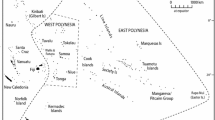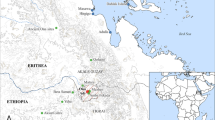Abstract
Archaeological survey in northwestern Saskatchewan identified sites ascribable to three resident ethnic/cultural groups: Chipewyan Indians, Cree/Metis Cree Indians and Euro-Canadians. Emphasis was placed on recording 19th and early 20th century sites, which are under-reported in the archaeological literature for the area. Archaeology, informant testimony and on-site interpretation of features, and ethnoarchaeological research on contemporary communities were combined to study ecological adaptations of the three populations and to define archaeological site formation processes. Each population adapted to the fur trade and to the other populations by filling specialized roles or occupations within the new mercantile system. Evidence for these different adaptations is discussed.
Similar content being viewed by others
References
Binford, Lewis R. 1978a Dimensional Analysis of Behavior and Site Structures: Learning From an Eskimo Hunting Stand. American Antiquity 43:330–61.
1978b Nunamiut Ethnoarchaeology. Academic Press, New York.
Brumbach, Hetty Jo and Robert Jarvenpa 1980 The Ecological History of Ethnic Adaptations in Central Subarctic Canada. Paper presented at the 45th Annual Meeting, Society for American Archaeology, Philadelphia.
Brumbach, Hetty Jo, Robert Jarvenpa, and Clifford Buell 1982 An Ethnoarchaeological Approach to Chipewyan Adaptations in the Late Fur Trade Period. Arctic Anthropology 19(1):1–49.
Brown, Jennifer 1976 A Demographic Transition in the Fur Trade Country: Family Sizes and Fertility of Company Officers and Country Wives, ca. 1759–1850. Western Canadian Journal of Anthropology. 6:66–71.
Clark, A. McFadyen and Donald W. Clark 1974 Koyukon Athapaskan Houses as Seen Through Oral Tradition and Through Archaeology. Arctic Anthropology 11:29–38.
Gould, Richard A. 1971 The Archaeologist as Ethnographer: A Case Study from the Western Desert of Australia. World Archaeology 3:143–77.
1980 Living Archaeology. Cambridge University Press, Cambridge.
Helm, June, Edward S. Rogers, and James G. E. Smith 1981 Intracultural Relations and Cultural Change in the Shield and Mackenzie Borderlands. In Handbook of North American Indians, Volume 6, Subarctic, edited by June Helm, pp. 146–57. Smithsonian Institution, Washington.
Hudson’s Bay Company Archives 1889–1891 Île à La Crosse Post Journals. Hudson’s Bay Company Archives B.89/a/36. Winnipeg.
1891–1896 Île à Crosse Post Journals. Hudson’s Bay Company Archives B.89/a/37. Winnipeg.
1892 Île à la Crosse Report. Inspection of English River District, 1892. Hudson’s Bay Company Archives B.89/e/15. Winnipeg.
1908–1910 Île à la Crosse Correspondence and Accounts. Hudson’s Bay Company Archives B.89/b/23, folio 23. Winnipeg.
1921–1939 Plans and Descriptions of Post Buildings: Central District, 1921–1939. Hudson’s Bay Company Archives, uncatalogued. Winnipeg.
Jarvenpa, Robert 1977 The Ubiquitous Bushman: Chipewyan-White Trapper Relations of the 1930s. In Problems in the Prehistory of the North American Subarctic: The Athapaskan Question, edited by J. W. Helmer, S. Van Dyke, and F. J. Kense, pp. 165–85. Archaeological Association of the University of Calgary.
1980 The Trappers of Patuanak: Toward a Spatial Ecology of Modern Hunters. National Museum of Man Mercury Series, Canadian Ethnology Service Paper No. 67. Ottawa.
Karras, A. L. 1970 North to Cree Lake. Trident Press, New York.
Meyer, David, James S. Wilson, and Olga Klimko 1981 Archaeological Mitigation Along the Key Lake Access Road. Saskatchewan Research Council Publication No. C-805-11-E-81.
Slobodin, Richard 1964 The Subarctic Metis as Products and Agents of Culture Contact. Arctic Anthropology 2(2):50–55.
Taylor, Walter W. 1948 A Study of Archeology. American Anthropological Association Memoir 69.
Vanstone, James W. 1968 Tikchik Village: A Nineteenth Century Riverine Community in Southwestern Alaska. Fieldiana: Anthropology, 56(3).
1970 Akulivichuk: A Nineteenth Century Eskimo Village on the Nushagak River, Alaska. Fieldiana: Anthropology, 60.
1971 Historic Settlement Patterns in the Nushagak River Region, Alaska. Fieldiana: Anthropology 61.
Yellen, John E. 1977 Archaeological Approaches to the Present: Models for Reconstructing the Past. Academic Press, New York.
Author information
Authors and Affiliations
Rights and permissions
About this article
Cite this article
Brumbach, H.J. The recent fur trade in Northwestern Saskatchewan. Hist Arch 19, 19–39 (1985). https://doi.org/10.1007/BF03373474
Published:
Issue Date:
DOI: https://doi.org/10.1007/BF03373474




